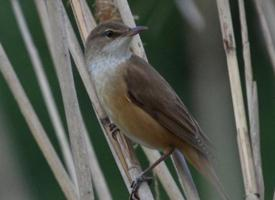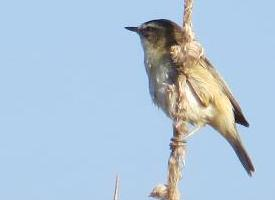
Statut de conservation
| Menacé |
Description de l'animal
The Moustached Warbler, scientifically known as Acrocephalus melanopogon, is a small, elusive bird that boasts a distinctive presence within its natural habitats. Primarily found across parts of Europe, Asia, and the northern fringes of Africa, this species is a true embodiment of adaptability and resilience, thriving in dense, wetland environments.Characteristically, the Moustached Warbler possesses a modest length of about 13 to 15 cm, making it one of the smaller members within the Acrocephalus genus. Despite its diminutive size, it is immediately recognizable by its rich, olive-brown upperparts that seamlessly blend into its surroundings. The underparts, in contrast, are a lighter buff, providing a subtle yet effective camouflage against predators. Its name derives from the distinctive black moustachial stripe that runs alongside its cheek, standing out against the bird's otherwise pale face and throat. This unique facial marking, coupled with a robust and slightly curved bill, lends the species both its common and scientific names.
One of the most fascinating aspects of the Moustached Warbler is its vocal prowess. The species is known for its complex and melodious song, a vibrant mix of trills, whistles, and sometimes mimicry of other bird calls. This vocalization plays a crucial role during the breeding season, as males use their songs to attract mates and assert territorial dominance over rivals. The intricate song is also a beacon for birdwatchers, often being the first indication of the bird's presence within its dense reedbed habitat.
Breeding habits of the Moustached Warbler are closely tied to its aquatic surroundings. The bird constructs its nest near the ground or just above water, intricately weaving together reeds and other plant materials to create a secure, hidden sanctuary for its eggs. Typically, the female lays between 3 to 6 eggs, which she incubates for about two weeks before they hatch. Both parents are involved in the upbringing of their young, showcasing a remarkable level of parental care that ensures the survival of the next generation.
The diet of the Moustached Warbler is predominantly insectivorous, consisting of small insects and larvae. However, it is known to diversify its diet with small aquatic invertebrates, particularly during the breeding season to meet the increased nutritional demands. This varied diet is facilitated by the bird's habitat, as the dense reedbeds and wetlands provide an abundant supply of food resources.
Conservation-wise, the Moustached Warbler is classified as of Least Concern by the International Union for Conservation of Nature (IUCN), indicating a stable global population. However, like many wetland species, it faces threats from habitat destruction and degradation, primarily due to agricultural expansion, water pollution, and climate change. Conservation efforts are thus focused on protecting and restoring wetland habitats to ensure the species' long-term survival.
In conclusion, the Moustached Warbler is a remarkable bird that embodies the beauty and complexity of wetland ecosystems. Its distinctive appearance, captivating song, and intricate breeding behaviors make it a species of interest not only for ornithologists but for anyone fascinated by the natural world. As efforts continue to preserve its habitats, the Moustached Warbler remains a symbol of the delicate balance between biodiversity and human activity.
Animaux similaires
Nouvelles photos d'animaux
Top 10 des animaux
- Dolphin gull (Leucophaeus scoresbii)
- Diana monkey (Cercopithecus diana)
- Moustached guenon (Cercopithecus cephus)
- Galápagos tortoise (Geochelone nigra complex)
- Russian tortoise (Testudo horsfieldii)
- Japanese macaque (Macaca fuscata)
- Stone loach (Barbatula barbatula)
- Greek tortoise (Testudo graeca)
- Common flying dragon (Draco volans)
- Colossal squid (Mesonychoteuthis hamiltoni)


